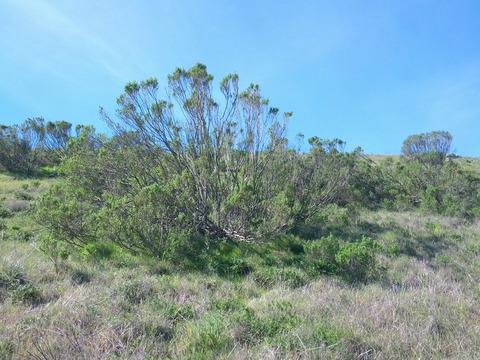当前位置:
X-MOL 学术
›
Appl. Veg. Sci.
›
论文详情
Our official English website, www.x-mol.net, welcomes your feedback! (Note: you will need to create a separate account there.)
Vegetation mapping using hierarchical object‐based image analysis applied to aerial imagery and lidar data
Applied Vegetation Science ( IF 2.8 ) Pub Date : 2019-12-15 , DOI: 10.1111/avsc.12467 Kellie A. Uyeda 1 , Kelsey K. Warkentin 1 , Douglas A. Stow 1 , John F. O'Leary 1 , Rachel A. Snavely 1 , Julie Lambert 2 , Leslie A. Bolick 3 , Kimberly O'Connor 4 , Bryan Munson 5 , Andrew C. Loerch 1
Applied Vegetation Science ( IF 2.8 ) Pub Date : 2019-12-15 , DOI: 10.1111/avsc.12467 Kellie A. Uyeda 1 , Kelsey K. Warkentin 1 , Douglas A. Stow 1 , John F. O'Leary 1 , Rachel A. Snavely 1 , Julie Lambert 2 , Leslie A. Bolick 3 , Kimberly O'Connor 4 , Bryan Munson 5 , Andrew C. Loerch 1
Affiliation

|
Aims: The primary objective of this study is to map the distribution and quantify the cover of vegetation alliances over the entirety of San Clemente Island (SCI). To this end, we develop and evaluate the mapping method of hierarchical object‐based classification with a rule‐based expert system. Location: San Clemente Island, California, USA. Methods: We developed and tested an approach based on hierarchical object‐based classification with a rule‐based expert system to effectively map vegetation communities on SCI following the Manual of California Vegetation classification system. In this mapping approach, the shrub species defining each vegetation community and non‐shrub growth forms were first mapped using aerial imagery and lidar data, then used as input in an automated mapping rule set that incorporates the percent cover rules of a field‐based mapping rule set. Results: The final vegetation map portrays the distribution of 19 vegetation communities across SCI, with the largest areas comprised of California Annual and Perennial Grassland (35%) and three types of coastal sage scrub and maritime succulent scrub, comprising a combined 53% of the area. Map accuracy was assessed to be 79% based on fuzzy methods and 61% with a traditional accuracy assessment. The accuracy of tree identification was assessed to be 81%, but species‐level tree accuracy was 45%. Conclusions: Semi‐automated approaches to vegetation community mapping can produce repeatable maps over large spatial extents that facilitate ecological management efforts. However, some low‐statured shrub community types were difficult to differentiate due to patchy canopies of co‐occurring species including abundant non‐native grasses characteristic of complex disturbance histories. Species‐level tree mapping accuracy was low due to the difficulty of identifying species within poorly illuminated canyons, resulting from sub‐optimal image acquisition timing.
中文翻译:

基于分层对象的图像分析应用于航空影像和激光雷达数据的植被映射
目的:本研究的主要目标是绘制整个圣克莱门特岛 (SCI) 的植被联盟的分布图并对其进行量化。为此,我们使用基于规则的专家系统开发和评估基于层次对象的分类的映射方法。地点:美国加利福尼亚州圣克莱门特岛。方法:我们开发并测试了一种基于分层对象分类和基于规则的专家系统的方法,以按照加州植被分类系统手册有效地在 SCI 上绘制植被群落。在这种制图方法中,首先使用航空影像和激光雷达数据绘制了定义每个植被群落和非灌木生长形式的灌木物种,然后用作自动映射规则集中的输入,该规则集中包含基于字段的映射规则集的百分比覆盖规则。结果:最终的植被图描绘了 SCI 中 19 个植被群落的分布,其中最大的区域包括加利福尼亚一年生和多年生草原(35%)以及三种类型的沿海鼠尾草灌木丛和海洋多肉灌木丛,占总面积的 53%区域。基于模糊方法的地图精度评估为 79%,传统精度评估为 61%。树木识别的准确率为 81%,但物种级别的树木准确率为 45%。结论:植被群落绘图的半自动方法可以在大空间范围内生成可重复的地图,从而促进生态管理工作。然而,一些低矮灌木群落类型难以区分,因为共生物种的冠层不完整,包括具有复杂干扰历史特征的丰富的非本地草。由于图像采集时间不理想,在光线不足的峡谷内难以识别物种,因此物种级树映射精度较低。
更新日期:2019-12-15
中文翻译:

基于分层对象的图像分析应用于航空影像和激光雷达数据的植被映射
目的:本研究的主要目标是绘制整个圣克莱门特岛 (SCI) 的植被联盟的分布图并对其进行量化。为此,我们使用基于规则的专家系统开发和评估基于层次对象的分类的映射方法。地点:美国加利福尼亚州圣克莱门特岛。方法:我们开发并测试了一种基于分层对象分类和基于规则的专家系统的方法,以按照加州植被分类系统手册有效地在 SCI 上绘制植被群落。在这种制图方法中,首先使用航空影像和激光雷达数据绘制了定义每个植被群落和非灌木生长形式的灌木物种,然后用作自动映射规则集中的输入,该规则集中包含基于字段的映射规则集的百分比覆盖规则。结果:最终的植被图描绘了 SCI 中 19 个植被群落的分布,其中最大的区域包括加利福尼亚一年生和多年生草原(35%)以及三种类型的沿海鼠尾草灌木丛和海洋多肉灌木丛,占总面积的 53%区域。基于模糊方法的地图精度评估为 79%,传统精度评估为 61%。树木识别的准确率为 81%,但物种级别的树木准确率为 45%。结论:植被群落绘图的半自动方法可以在大空间范围内生成可重复的地图,从而促进生态管理工作。然而,一些低矮灌木群落类型难以区分,因为共生物种的冠层不完整,包括具有复杂干扰历史特征的丰富的非本地草。由于图像采集时间不理想,在光线不足的峡谷内难以识别物种,因此物种级树映射精度较低。



























 京公网安备 11010802027423号
京公网安备 11010802027423号